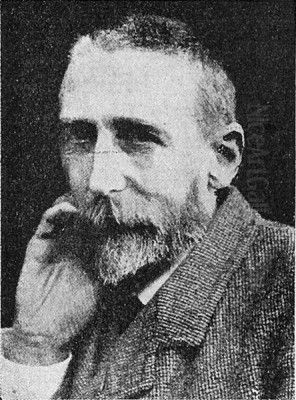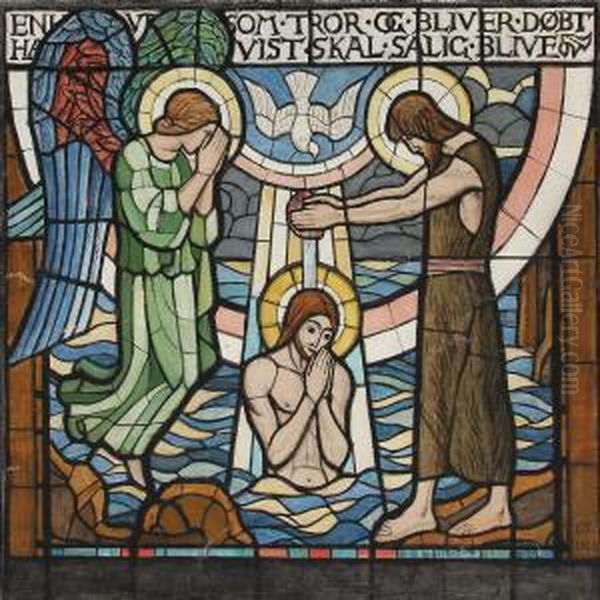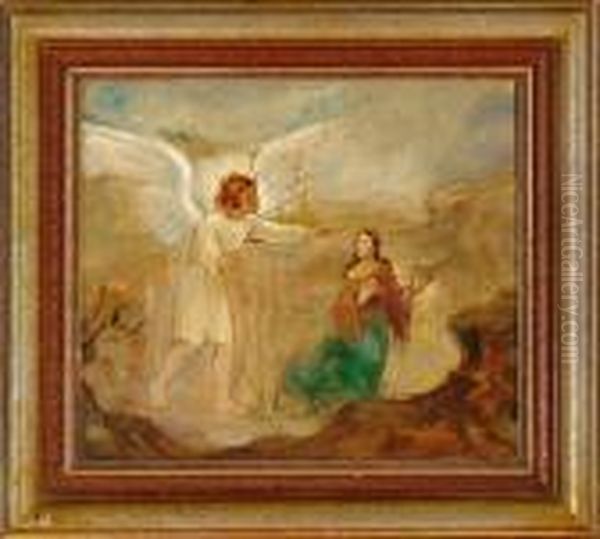
Joakim Frederik Skovgaard (1856-1933) stands as a colossus in the landscape of Danish art, a painter, sculptor, and decorative artist whose monumental works, particularly his religious frescoes, have left an indelible mark on Denmark's cultural and spiritual heritage. Born into an artistic dynasty and navigating the currents of Realism, Symbolism, and National Romanticism, Skovgaard forged a unique visual language that resonated deeply with the Danish psyche. His life and career offer a fascinating window into the artistic ferment of late 19th and early 20th century Scandinavia.
Early Life and Artistic Lineage
Joakim Skovgaard was born in Copenhagen on November 18, 1856. Art was in his blood; he was the son of Peter Christian Skovgaard (P.C. Skovgaard), one of the foremost landscape painters of the Danish Golden Age, a period renowned for its celebration of Danish nature and national identity through artists like C.W. Eckersberg and Christen Købke. His mother, Georgia Schou, also contributed to the artistic environment of the household. Joakim was one of three artist siblings, with his brother Niels Skovgaard also achieving recognition as a painter and sculptor, and his sister Susette Holten (née Skovgaard) becoming a painter and ceramicist.
This familial immersion in art provided Joakim with an unparalleled early education. He received initial instruction in drawing and painting directly from his distinguished father, absorbing the principles of careful observation and a deep reverence for nature that characterized the Golden Age. This foundational training was formalized when he enrolled at the Royal Danish Academy of Fine Arts in Copenhagen, studying there from 1871 to 1876. The Academy, while steeped in tradition, was also beginning to feel the winds of change sweeping across European art.
Parisian Realism and Broadening Horizons

To further hone his skills and expose himself to contemporary artistic trends, Skovgaard, like many aspiring artists of his generation, traveled to Paris. From 1880 to 1881, he studied at the independent school run by Léon Bonnat, a prominent academic painter known for his portraiture and historical scenes, and a staunch advocate of Realism. Bonnat's emphasis on anatomical accuracy, precise draughtsmanship, and the unvarnished depiction of reality, as championed by French artists like Gustave Courbet, undoubtedly influenced Skovgaard's technical proficiency and his approach to figurative representation.
However, Skovgaard's artistic vision was not to be confined by a single school of thought. The 1880s were a period of significant travel and artistic exploration for him. Crucially, he embarked on journeys to Italy and Greece, often in the company of his close friend and fellow Danish artist, Kristian Zahrtmann. Zahrtmann, a flamboyant and influential figure, was known for his historical paintings and his role as a teacher to a generation of Danish modernists. These travels were transformative for Skovgaard.
In Italy, he immersed himself in the art of the early Renaissance masters, studying their fresco techniques, narrative clarity, and profound spirituality. The monumental scale and emotional directness of artists like Giotto and Fra Angelico left a lasting impression. In Greece, he encountered the remnants of classical antiquity and was also captivated by the vibrant traditions of Greek folk art. This exposure to diverse artistic heritages, from the classical to the vernacular, broadened his aesthetic palette and deepened his understanding of art's communicative power. During this period, he also came under the influence of the Danish painter Theodor Philipsen, a pioneer of Danish Impressionism, whose handling of light and color may have subtly informed Skovgaard's own evolving style, particularly in his landscape and genre scenes.
The Rise of Symbolism and Monumental Ambitions
The experiences in Italy and Greece, coupled with the prevailing intellectual currents of the late 19th century, steered Skovgaard increasingly towards Symbolism. This movement, which sought to express deeper meanings, emotions, and spiritual ideas rather than merely depicting objective reality, found fertile ground in Skovgaard's temperament and his growing preoccupation with religious themes. He began to move away from straightforward Realism, imbuing his work with a more profound, often mystical, sensibility.

Skovgaard's ambition was not limited to easel painting. He was drawn to monumental art, to creating works that could engage a wider public and transform architectural spaces. This led him to explore various decorative techniques, including stained glass and mosaic, but it was in the art of fresco painting that he would find his most powerful and enduring medium. His deep Christian faith became the wellspring of his most significant artistic endeavors, as he sought to translate biblical narratives into compelling visual forms for contemporary audiences.
The Crowning Achievement: Viborg Cathedral
Joakim Skovgaard's name is inextricably linked with the decoration of Viborg Cathedral (Viborg Domkirke). This monumental undertaking, which occupied him for five years from 1901 to 1906 (though preparatory work began earlier, around 1899-1900, and continued with additions until 1913), is widely considered one of the most important artistic achievements in Danish history. The original medieval frescoes of the cathedral had been lost, and Skovgaard was commissioned to create an entirely new decorative scheme covering the vaults, walls, and ceilings of the nave, choir, and transepts.
Working with a team of assistants, including the notable painter Niels Larsen Stevns, who would himself become a significant figure in Danish modernism, Skovgaard covered vast expanses of the cathedral's interior with scenes from the Old and New Testaments. His frescoes depict key biblical stories, from the Creation and the Fall of Man to the Life of Christ and the Apocalypse, rendered in a style that is both monumental and deeply human.
The Viborg frescoes are characterized by their narrative clarity, strong compositions, and a distinctive color palette that harmonizes with the Romanesque architecture of the cathedral. Skovgaard's figures are solid and expressive, conveying a sense of spiritual gravitas. He masterfully blended influences from early Christian and Byzantine art, Italian Renaissance frescoes, and a distinctly Nordic sensibility. The overall effect is one of overwhelming spiritual grandeur, transforming the cathedral into a vibrant "Biblia Pauperum" – a Bible for the poor or illiterate, communicating sacred stories through powerful imagery. The project was a testament to Skovgaard's immense skill, his profound religious conviction, and his capacity for sustained artistic labor on an epic scale. The completion of the Viborg frescoes cemented his reputation as Denmark's foremost religious painter.
"Christ in the Realm of the Dead" and Other Major Works
While Viborg Cathedral remains his magnum opus, Skovgaard produced other highly significant works that showcase his artistic range and thematic concerns. Among these, "Kristus i Dødsriget" (Christ in the Realm of the Dead), painted between 1891 and 1894, stands out. This large-scale painting, now in the collection of the Statens Museum for Kunst (National Gallery of Denmark), is a powerful and dramatic interpretation of Christ's descent into Hades.
The painting depicts a monumental Christ figure, radiating light, amidst a throng of souls awaiting redemption. The composition is dynamic, with a swirling vortex of figures rendered with a raw, almost primal energy. The work is notable for its intense emotionalism and its departure from conventional iconographic representations. It is often cited as a key work of Danish Symbolism and even touches upon the emerging aesthetics of Art Nouveau, or "Skønvirke" as it was known in Denmark, with its flowing lines and decorative qualities. The painting caused considerable debate upon its exhibition, admired for its power but also questioned for its unconventional portrayal of a sacred subject.
Skovgaard also undertook other significant church commissions. He created an altarpiece for Copenhagen Cathedral (Church of Our Lady), and in 1890, he painted "Christ Leading the Thief into Paradise" for the same church. His explorations extended to glass painting and mosaic art, further demonstrating his versatility as a decorative artist. One of his earlier notable paintings, "The Southwest Corner of the Parthenon" (1884), reflects his classical interests stemming from his Greek travels, showcasing his meticulous attention to detail and atmospheric rendering. Another religious work, "Angels Stirring the Waters," illustrates his continued engagement with biblical scenes, interpreted through his unique artistic lens.
Artistic Style: A Synthesis of Influences
Joakim Skovgaard's artistic style is a complex synthesis of various influences, unified by his strong personal vision and profound spirituality. His grounding in the Danish Golden Age tradition, inherited from his father, P.C. Skovgaard, instilled in him a respect for meticulous observation and craftsmanship. His Parisian training under Léon Bonnat provided him with the technical mastery of Realist figuration.
However, it was his engagement with Italian Renaissance art, Greek folk traditions, and the broader European Symbolist movement that truly shaped his mature style. He moved beyond mere representation to explore the symbolic and emotional dimensions of his subjects, particularly in his religious works. His figures, while often monumental and idealized, possess a tangible human quality and psychological depth.
His compositions are typically well-structured and balanced, yet often infused with a dynamic energy, especially in dramatic scenes like "Christ in the Realm of the Dead." His color palette could range from somber and earthy tones to moments of luminous intensity, always employed to enhance the narrative and emotional impact of the work. There is a distinctly Nordic character to his art, a certain gravity and introspection that distinguishes it from, say, French or Italian Symbolism. He shared this Nordic sensibility with contemporaries across Scandinavia, such as Edvard Munch in Norway, though Skovgaard's art remained more rooted in Christian iconography and less overtly focused on personal angst.
Skovgaard's Circle: Contemporaries and Collaborators
Joakim Skovgaard did not operate in an artistic vacuum. He was part of a vibrant Danish art scene and interacted with numerous contemporaries who were shaping the course of modern art in Denmark. His closest artistic relationship was arguably with his brother, Niels Skovgaard, with whom he shared a deep artistic bond and often collaborated or exhibited.
Kristian Zahrtmann was another pivotal figure in his life, not only as a travel companion but also as an intellectual sparring partner whose own bold approach to color and historical subjects provided a stimulating counterpoint to Skovgaard's more monumental and spiritually focused art. The influence of Theodor Philipsen, with his Impressionistic leanings, shows Skovgaard's openness to different stylistic approaches early in his career.
In the context of Danish Symbolism and the Skønvirke movement, Skovgaard's work can be seen alongside that of artists like J.F. Willumsen, whose highly individualistic and often provocative Symbolist works pushed the boundaries of Danish art. Other important figures in this milieu included Agnes Slott-Møller and Harald Slott-Møller, who, like Skovgaard, drew on national history, myth, and a decorative sensibility. Thorvald Bindesbøll, a leading architect and designer, was a key proponent of the Skønvirke style, and while their primary media differed, Skovgaard's decorative ambitions aligned with the movement's ethos of integrating art into everyday life and architectural spaces.
The Skagen Painters, such as P.S. Krøyer, Michael Ancher, and Anna Ancher, represented a different, though contemporaneous, strand of Danish art, focusing on Realist and Impressionist depictions of life in the fishing village of Skagen. While Skovgaard's path diverged from theirs thematically and stylistically, they were all part of the broader artistic flourishing in Denmark at the turn of the century. Figures like Laurits Andersen Ring, with his socially conscious Realism tinged with Symbolism, and Vilhelm Hammershøi, known for his enigmatic and poetic interiors, further illustrate the diversity of the Danish art scene during Skovgaard's active years. His collaboration with Niels Larsen Stevns on the Viborg Cathedral project is particularly noteworthy, as Stevns would go on to become a major religious painter in his own right, clearly influenced by his work alongside Skovgaard.
Teaching, Legacy, and the Skovgaard Museum
Beyond his prolific output as an artist, Joakim Skovgaard made significant contributions to Danish art education. He served as a teacher at the Royal Danish Academy of Fine Arts's school for decorative arts, and in 1909 he was appointed a professor at the Academy, a position he held until 1924. In this role, he influenced a new generation of Danish artists, passing on his technical knowledge and his vision for an art that was both spiritually meaningful and integrated with public life.
Skovgaard's personal life was marked by a deep love for freedom and the countryside. He expressed a desire to live year-round in rural settings, a sentiment that perhaps reflected a yearning for a simpler, more authentic existence away from the complexities of Copenhagen. He also valued practical experience and direct engagement, believing that travel and cultural exchange were vital aspects of an artist's work and development.
Joakim Skovgaard passed away in Copenhagen on March 9, 1933. His legacy is preserved not only in the churches and museums that house his works but also in the Skovgaard Museum in Viborg. Established in 1937, the museum is dedicated to the art of Joakim Skovgaard and his family, including his father P.C. Skovgaard and his siblings Niels and Susette. It holds an extensive collection of their paintings, drawings, sculptures, and ceramics, providing a comprehensive overview of this remarkable artistic dynasty and its contribution to Danish National Romanticism and Symbolism.
His works continue to be studied and admired for their technical brilliance, their emotional depth, and their profound spiritual resonance. The Viborg Cathedral frescoes, in particular, remain a pilgrimage site for art lovers and a testament to the enduring power of religious art.
Conclusion: An Enduring Monumental Vision
Joakim Skovgaard was a pivotal figure in Danish art, bridging the 19th-century traditions of the Golden Age and Realism with the modern sensibilities of Symbolism and Art Nouveau. His unwavering commitment to religious themes, expressed on a monumental scale, provided Denmark with some of its most cherished artistic treasures. He successfully synthesized international artistic currents with a distinctly Nordic spirit, creating a body of work that is both deeply personal and universally resonant. Through his paintings, frescoes, and decorative arts, as well as his influential role as an educator, Joakim Skovgaard profoundly shaped the artistic landscape of Denmark and left a legacy that continues to inspire awe and contemplation. His life's work stands as a powerful affirmation of art's capacity to explore the deepest questions of human existence and spirituality.